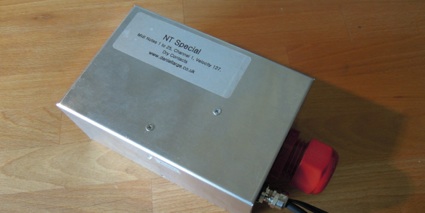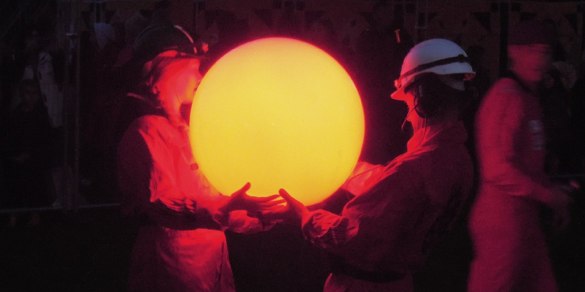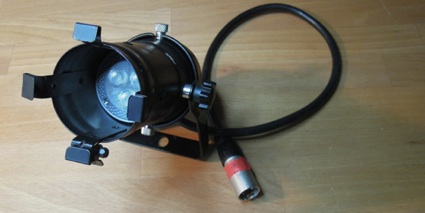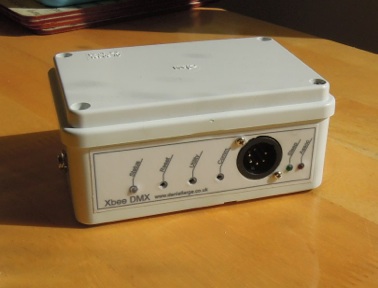
For flashing out your bar or truss before you fly it out.
With neon so you know when you have popped the 15A breaker.

For flashing out your bar or truss before you fly it out.
With neon so you know when you have popped the 15A breaker.
 I have supplied and installed a 25 button to MIDI interface for the Warhorse exhibition in the National Theatre. The button interface takes input from 25 buttons mounted in a wall and fires a Qlab computer to playback an interview of choice to listeners on headphones.
I have supplied and installed a 25 button to MIDI interface for the Warhorse exhibition in the National Theatre. The button interface takes input from 25 buttons mounted in a wall and fires a Qlab computer to playback an interview of choice to listeners on headphones.
The unit is based on the XGO Mini project for Have Sound.
 I have recently supplied 10 wirelessly colour changing LED orbs to Walk the Plank and lighting designer Adam Povey. The orbs were used in their ‘Sparks Will Fly’ event in Chelmsford, part of a festival to mark the passing of the Olympic Torch through Essex. The orbs were controlled from the lighting desk as part of the main lighting design. One descended by parachute in the hands of a Red Devil.
I have recently supplied 10 wirelessly colour changing LED orbs to Walk the Plank and lighting designer Adam Povey. The orbs were used in their ‘Sparks Will Fly’ event in Chelmsford, part of a festival to mark the passing of the Olympic Torch through Essex. The orbs were controlled from the lighting desk as part of the main lighting design. One descended by parachute in the hands of a Red Devil.
 So i’ve got bored of the flickering birdie transformers, the plugs that are almost as big as the lamps, and the socca spider on the front of the stage just to get a bit of nice looking foot light.
So i’ve got bored of the flickering birdie transformers, the plugs that are almost as big as the lamps, and the socca spider on the front of the stage just to get a bit of nice looking foot light.
Behold the LED Birdie.
Powered from your 24V scroller PSU, the birdie has a 4 pin XLR in and out (just like a scroller) so you can loop them together with your existing 4pin scroller cable. Inside is a tiny DMX decoder and LED dimmer. The birdie takes one of the new 12V MR16 high-power LED Lamps. Addressing is set with a single switch (operated by paper clip) – Set the channel and only that channel to be used 50% or more on your console or DMX tester and press the button. Done!
Depending on your PSU, you should be able to run a fairly serious amount on one line, due to the tiny current requirements.
I will be using these this summer with a car battery instead of a scroller PSU, for a bit of mains free dimmable, easily controllable light.
These are some photos of the first run of birdies. They were used to light Goat and Monkeys ‘The Seed’ project in a yurt in Wakehurst Place Gardens, East Sussex.
Building on the XBee to PWM idea, I am currently working on a simple radio dimming system to dim some LED RGB strip via a DMX input, this time using an XRF module as the communications base. Boards are being prototyped, photos of testing to follow!
 Februarys project is a wireless one. And closer to home that the recent sound control projects. The problem – wireless control of 3 channels of LED strip, powered by batteries and controlled by a lighting desk. There are a number of products already on the market to do this of course, but for this system we need many nodes without the cost.
Februarys project is a wireless one. And closer to home that the recent sound control projects. The problem – wireless control of 3 channels of LED strip, powered by batteries and controlled by a lighting desk. There are a number of products already on the market to do this of course, but for this system we need many nodes without the cost.
The idea is quite simple, receive DMX, store only the values that we need and transmit out via a serial network of Xbee radio devices. The devices will each receive a set start address and provide 3 meaty PWM outputs for controlling the LEDs.
A project of two halves. A transmitter and receiver.
 The XGO Pro is another collaboration with HAVE, this time on a device that is capable of switching toggling a KVM, changing the patch on an APATCHE (or other Sysex fired device) and provide contact closures to MIDI buttons. This switchover box contains USB MIDI cards to allow the connection of two complete sound playback systems and with one button, noiselessly transfer from one to the other, from an audience and operators perspective. “XGO” is X for crossover and GO the input from a button panel GOs, BACKs etc that are distributed to both systems.
The XGO Pro is another collaboration with HAVE, this time on a device that is capable of switching toggling a KVM, changing the patch on an APATCHE (or other Sysex fired device) and provide contact closures to MIDI buttons. This switchover box contains USB MIDI cards to allow the connection of two complete sound playback systems and with one button, noiselessly transfer from one to the other, from an audience and operators perspective. “XGO” is X for crossover and GO the input from a button panel GOs, BACKs etc that are distributed to both systems.
This device is now built an in a testing and evaluation phase.
 A new project for 2012. Based on the TouchEmulate boxes, I have created a simpler, smaller unit to output DMX only.
A new project for 2012. Based on the TouchEmulate boxes, I have created a simpler, smaller unit to output DMX only.
This makes a handy DMX remote combined with TouchOSC (for Android & iPhone or DMX Focus from Foo Bar Interactive (for the iPhone) and a router.
The box accepts OSC commands to set channel levels over the network and has a web interface for setup. A simple, mobile phone or tablet remote for your dimmers, just add a wireless access point of your choice.
You can configure the IP address of the unit via a web interface in a similar manner to setting up a router.